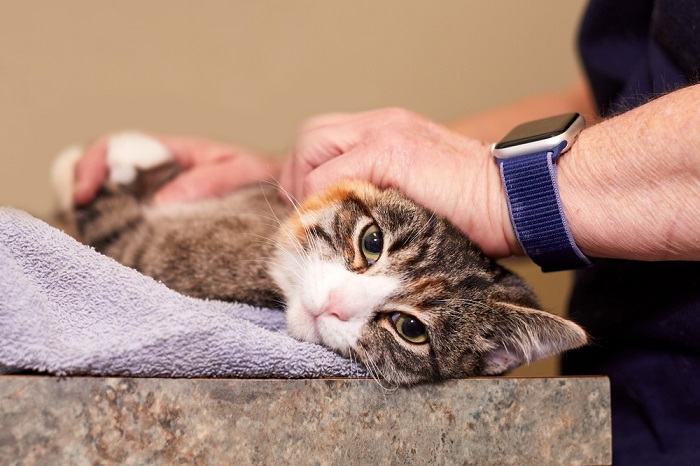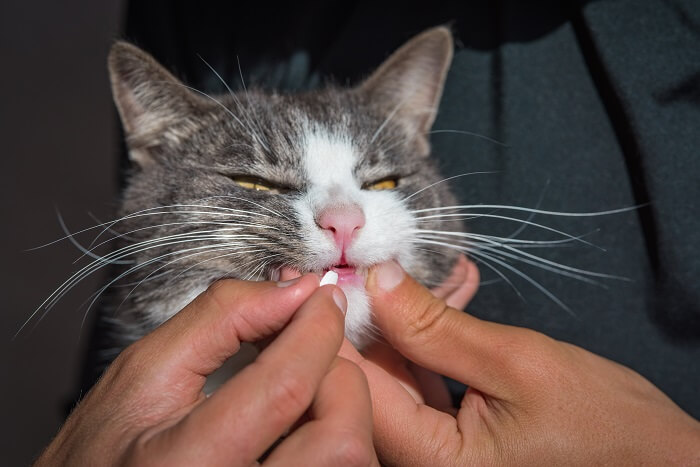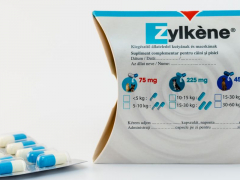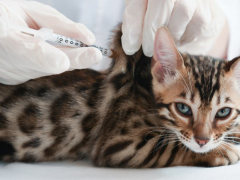
Tramadol is a common opioid pain medication that may be used in cats. In this article, you’ll learn how tramadol works, side effects to monitor for, and some frequently asked questions.
Tramadol for Cats Overview

About Tramadol for Cats

Trimodal is not FDA-approved for cats, but veterinarians commonly prescribe it off-label.
Tramadol is an opioid pain medication. Opioids are a family of analgesics which means they bind to certain receptors in the body to provide pain relief. There are different types of opioid receptors in the body. Tramadol is able to bind specifically to what is called the mu receptor to provide pain relief.
It also has a mild ability to block the uptake of the two neurotransmitters: serotonin and norepinephrine.
In the US, tramadol is a schedule IV controlled substance. This means that a veterinarian’s ability to prescribe tramadol may be restricted based on when a pet was last examined or some other special conditions.
While it has been used in veterinary medicine for a long time, tramadol is not FDA-approved for use in dogs or cats. When prescribed, is done so in an off-label manner, which is common in veterinary medicine.
Also Read: What Can You Give A Cat For Pain? 6 Vet-Recommended Options
What Does Tramadol Do for Cats?

Tramadol may be used for pain in cats, but it is often not the first choice for a prescribing veterinarian.
Tramadol may be used for symptoms of both acute and chronic pain. For acute pain, it may provide relief within 1-2 hours. For chronic pain, such as with osteoarthritis of the joints, there is some evidence that tramadol may take up to two weeks for full effects to occur in chronic conditions.
Interestingly, more recent evidence has shown that tramadol provides questionable analgesia (pain relief) in dogs. Cats, however, appear to have a more robust response to it and it appears to have more of an analgesic effect.
While cats may respond better to tramadol than dogs, there are still other pain medications that may be preferred over tramadol. Buprenorphine, for example, provides a faster onset of pain relief. Gabapentin may provide better calming and sedating qualities.
Also Read: Best Calming Aid For Cats
Side Effects of Tramadol for Cats

Side effects and complications from tramadol are varied, and safe dosage should only be decided by a veterinarian.
Because it is not used as often in cats, there is more limited information available on the scope of trimodal’s adverse effects in kitties.
The most commonly reported side effects in cats include nausea, vomiting, sedation, mydriasis (large pupils), and change in behavior.
Behavior changes range from euphoria to dysphoria. Euphoric cats appear overtly affectionate and attentive or have an increased amount of energy. Dysphoric cats may appear confused, imbalanced, and more vocal than normal.
Constipation may also be seen with tramadol, so it is important to be cautious if your cat already has issues with firmer or harder stools.
Many cats may find commercial tramadol tablets unpalatable. This may lead to spitting the medication out, excessive drooling, and avoidance behavior during future attempts to administer the medication.
Overdoses are uncommon but have been reported. Signs of toxicity associated with tramadol include the acute onset of the side effects listed above. These adverse effects also include enlarged pupils, excessive drooling, lethargy, balance and coordination difficulty, elevated heart rate, and vomiting.
Because tramadol has the ability to block the reuptake of the neurotransmitter serotonin, extremely high doses can lead to an effect called serotonin syndrome. This happens when serotonin builds up too high in the body.
There are several signs associated with serotonin syndrome that affect different parts of the body. These can include agitation and restlessness, excessive vocalizing, confusion, seizures, vomiting and diarrhea, excessive drooling, elevated heart rate, high temperature, and rapid breathing.
Serotonin syndrome is unlikely to occur in cats except in cases of higher doses or if tramadol is combined with another medication that also prevents serotonin reuptake. This is considered an additive effect.
While dosing recommendations may vary widely in cats, these effects have been seen in older cats at doses higher than 2 milligrams per kilogram (about 1 milligram per pound).
There are some drug interactions that can occur with tramadol. Drugs that may increase the risk of serotonin syndrome if given together with tramadol include (but are not limited to):
- Mirtazapine
- Trazodone
- Diphenhydramine
- Hydroxyzine
- Ketoconazole
- Alprazolam and diazepam
- Gabapentin
- Levetiracetam (Keppra)
- Buprenorphine
- Phenobarbital
- S-Adenosyl methionine (SAMe)
- Fluoxetine
- Amitriptyline
The efficacy of tramadol may be decreased for cats on the appetite stimulant cyproheptadine.
As cats cannot metabolize acetaminophen and it causes toxic effects, the combination medication Ultracet which combines tramadol and acetaminophen should never be used in cats.
If you are ever concerned that your kitty may have developed side effects while using tramadol or if an overdose is suspected, make sure to contact your veterinarian, the ASPCA Animal Poison Control Center (1-888-426-4435), or Pet Poison Helpline (1-855-764-7661) immediately for further advice.
Also Read: Poisoning In Cats: Causes, Symptoms, and Treatment
Tramadol for Cats Dosage

The precise dosing of tramadol for cats can be best determined by a veterinarian.
The dosing of tramadol for cats can vary widely. It should only be used as directed by a licensed veterinarian.
Most cats should not be dosed with more than ¼ of the commonly available 50 mg commercial tablet size. This equates to about 12.5mg. Some research in cats has shown that signs of overdosage side effects may occur at only 2 milligrams per kilogram (1 milligram per pound).
For perspective, if an average 10-12lb cat received just one 50mg tablet of tramadol, this would be 2.5x higher than what is considered by many to be a safe upper limit of the dose.
This highlights the importance of not administering human medications to your cat that you may have at home without seeking out advice from a licensed veterinarian first. Even if your kitty is in pain and you want to give something to alleviate it, more harm than good may be done without properly consulting a veterinary professional first.
In order to provide a more precise dose that is safest for a cat, your veterinarian may explore the option of having the medication reformulated through a compounding pharmacy.
Also Read: 12 Warning Signs Your Cat Is In Pain And Crying For Help
Conclusion

While tramadol is commonly used to address acute and chronic pain in humans, it is a less popular choice for treating pain in cats.
Tramadol is an opioid pain medication that may be used in cats, though it is often not a first choice. This is due to issues with palatability and a narrower margin of safety in its usage. It also has a longer onset of action for chronic pain than other medications do. Although a common pain medication for humans, tramadol should never be given at home to a cat without consulting first with a licensed veterinarian.
Also Read: Are Cats In Pain When In Heat?
Drug Dosing Disclaimer: We are only able to provide doses for medications that are FDA approved for use in cats and only as the label guidelines dictate. For medications that are used off-label we can only provide guidelines and safety information for use. Safe and appropriate dosing for off-label medications can only be determined by a primary care veterinarian.
We encourage you to work with your veterinarian to determine if a particular medication is appropriate for your cat. Changing or adjusting a dose for your cat on your own without consulting with a veterinarian can carry risk. We do not encourage use of medications prescribed for human use in pets without first consulting with a primary care veterinarian.
Frequently Asked Questions
What is tramadol used for?
Tramadol is an opioid pain medication in an oral tablet form that is commonly used in veterinary medicine for relief of acute and chronic pain.
Should you crush tramadol before use in cats?
Generally, regular tramadol 50mg tablets can be split or crushed if needed to aid in administration. In fact, since only 50mg tablets are commercially available, a tablet would have to be split into at least ¼ pieces to safely dose many cats.
Crushing and dissolving in canned food gravy or water may reduce the efficacy of the medication. However, it may be pursued in cases where you and your veterinarian feel this is the most effective administration method.
There is a long-acting, extended-release version of tramadol under a few different brand names, which should never be split or crushed. However, the extended release forms are in dosages too high to give to cats safely and should be avoided anyway.
Is tramadol 50mg available over the counter?
No, tramadol cannot be obtained over the counter. Because of its potential to be abused, tramadol is a schedule IV controlled substance in the United States. It can only be obtained with a prescription from a licensed veterinarian. Because of its controlled status, there may be additional restrictions on the prescription, including the need for an updated bi-annual (6-month) exam and a limited number of refills.
How quickly does tramadol work?
For cats, it depends on what type of pain is present. In cases of acute pain, such as from a recent injury, tramadol may take up to 1-2 hours to provide pain relief after oral dosing. For chronic pain, such as with osteoarthritis, tramadol can have a long onset of action, sometimes taking up to 2 weeks to show benefits.







